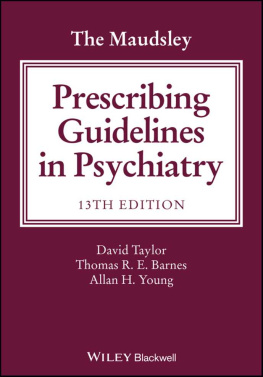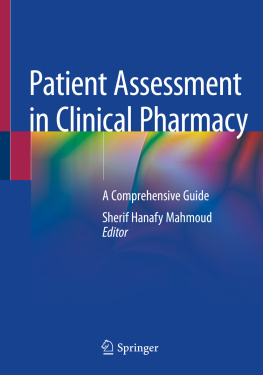Get ahead!
The Prescribing Safety Assessment
Get ahead!
The Prescribing
Safety
Assessment
Muneeb Choudhry GP Director AT Medics,
Undergraduate Tutor SGUL, GP Trainer, London, UK
Nicholas Fuggle Medical Registrar, Brighton, UK
Amar Iqbal Pharmacist, Heart Hospital, Birmingham, UK
Series Editor
Saran Shantikumar Academic Clinical Fellow in Public
Health, University of Warwick, UK
CRC Press
Taylor & Francis Group
6000 Broken Sound Parkway NW, Suite 300
Boca Raton, FL 33487-2742
2016 by Muneeb Choudhry, Nicholas Fuggle, and Amar Iqbal
CRC Press is an imprint of Taylor & Francis Group, an Informa business
No claim to original U.S. Government works
Printed on acid-free paper
Version Date: 20160505
International Standard Book Number-13: 978-1-4987-1906-3 (Paperback)
This book contains information obtained from authentic and highly regarded sources. While all reasonable efforts have been made to publish reliable data and information, neither the author[s] nor the publisher can accept any legal responsibility or liability for any errors or omissions that may be made. The publishers wish to make clear that any views or opinions expressed in this book by individual editors, authors or contributors are personal to them and do not necessarily reflect the views/opinions of the publishers. The information or guidance contained in this book is intended for use by medical, scientific or health-care professionals and is provided strictly as a supplement to the medical or other professionals own judgement, their knowledge of the patients medical history, relevant manufacturers instructions and the appropriate best practice guidelines. Because of the rapid advances in medical science, any information or advice on dosages, procedures or diagnoses should be independently verified. The reader is strongly urged to consult the relevant national drug formulary and the drug companies and device or material manufacturers printed instructions, and their websites, before administering or utilizing any of the drugs, devices or materials mentioned in this book. This book does not indicate whether a particular treatment is appropriate or suitable for a particular individual. Ultimately it is the sole responsibility of the medical professional to make his or her own professional judgements, so as to advise and treat patients appropriately. The authors and publishers have also attempted to trace the copyright holders of all material reproduced in this publication and apologize to copyright holders if permission to publish in this form has not been obtained. If any copyright material has not been acknowledged please write and let us know so we may rectify in any future reprint.
Except as permitted under U.S. Copyright Law, no part of this book may be reprinted, reproduced, transmitted, or utilized in any form by any electronic, mechanical, or other means, now known or hereafter invented, including photocopying, microfilming, and recording, or in any information storage or retrieval system, without written permission from the publishers.
For permission to photocopy or use material electronically from this work, please access www.copyright.com (http://www.copyright.com/) or contact the Copyright Clearance Center, Inc. (CCC), 222 Rosewood Drive, Danvers, MA 01923, 978-750-8400. CCC is a not-for-profit organization that provides licenses and registration for a variety of users. For organizations that have been granted a photocopy license by the CCC, a separate system of payment has been arranged.
Trademark Notice: Product or corporate names may be trademarks or registered trademarks, and are used only for identification and explanation without intent to infringe.
Visit the Taylor & Francis Web site at
http://www.taylorandfrancis.com
and the CRC Press Web site at
http://www.crcpress.com
Contents
I am pleased to have the opportunity to write a few words for this new book.
It is very clear that the need for publications which support clinicians in training such as medical students and pharmacists at the undergraduate and preregistration levels as well as beyond, to improve and support their professional practice, is essential. The content can also be of value to other healthcare professionals, for example nurse practitioners who are developing their clinical practice as prescribers.
Im sure this book will prove invaluable to clinicians in training taking the new forms of preregistration exams in their chosen fields. The format is particularly useable because it is divided into eight clinical specialties of relevance to the newly qualified prescriber. These specialties are then cross populated into six prescribing safety areas: prescribing, prescription review, adverse drug reactions, calculations, interpreting data and how to communicate information effectively.
Throughout my career, I have sought to expand my knowledge and capability as the demands on newly qualified clinicians and indeed clinicians of greater experience have continued to grow. This book speeds up some of that learning and will improve clinical confidence.
I was one of the first pharmacists to train as a prescriber, initially as a supplementary prescriber, and my competency development was based on the limited resources that I had to identify through a personal trawl through documents, papers and assorted books. This book has collated some of that search into a readable and useable format to enhance the journey of learning and development.
I have found the book a delight to read, and I commend the authors on a very useful addition to the library of learning.
Ashok Soni OBE FFRPS FRPharmS
President (Royal Pharmaceutical Society)
LPN Pharmacy Chair (London)
Clinical Network Pharmacy Lead (NHS Lambeth CCG)
The prescribing of drugs or their antecedents goes back a long way: the journey from the apothecaries of old to the modern delivery of powerful and potentially harmful drugs has taken many hundreds, perhaps thousands, of years. Along the way medicine has developed, and mirrored scientific progress as it has done so.
So the 21st-century doctor has an armamentarium of medicines at her disposal, of which she will develop a knowledge through undergraduate and postgraduate training, and with the expectation that she will administer them safely and with efficacy. The learning that takes place is a complex journey and now is to be formally assessed under UK regulation, in its own right, in addition to the other examination processes regulated by the General Medical Council (GMC).
Drug prescription, having been formalized into a doctor-only process over the last century or so, has now been extended to other professions. So-called non-medical prescribing can be part of the professional development of many other disciplines: nurses, physiotherapists and podiatrists for example. Even pharmacists, whose relationship to medicines might be said to be closer than anyones, can in the UK prescribe over the counter, pharmacist only and now prescription only medicines (where they have done the appropriate training).
For doctors, the prescription of medicines has always been integral to clinical practice, and is assessed at an undergraduate level in final examinations. At the time of writing, medical schools have the option to include a Prescribing Safety Assessment (PSA) within their own assessments, or use the PSA to which this book is directed. Time will tell, but the PSA is likely to be the definitive prescribing assessment in the future. This direction of travel was set in train by











